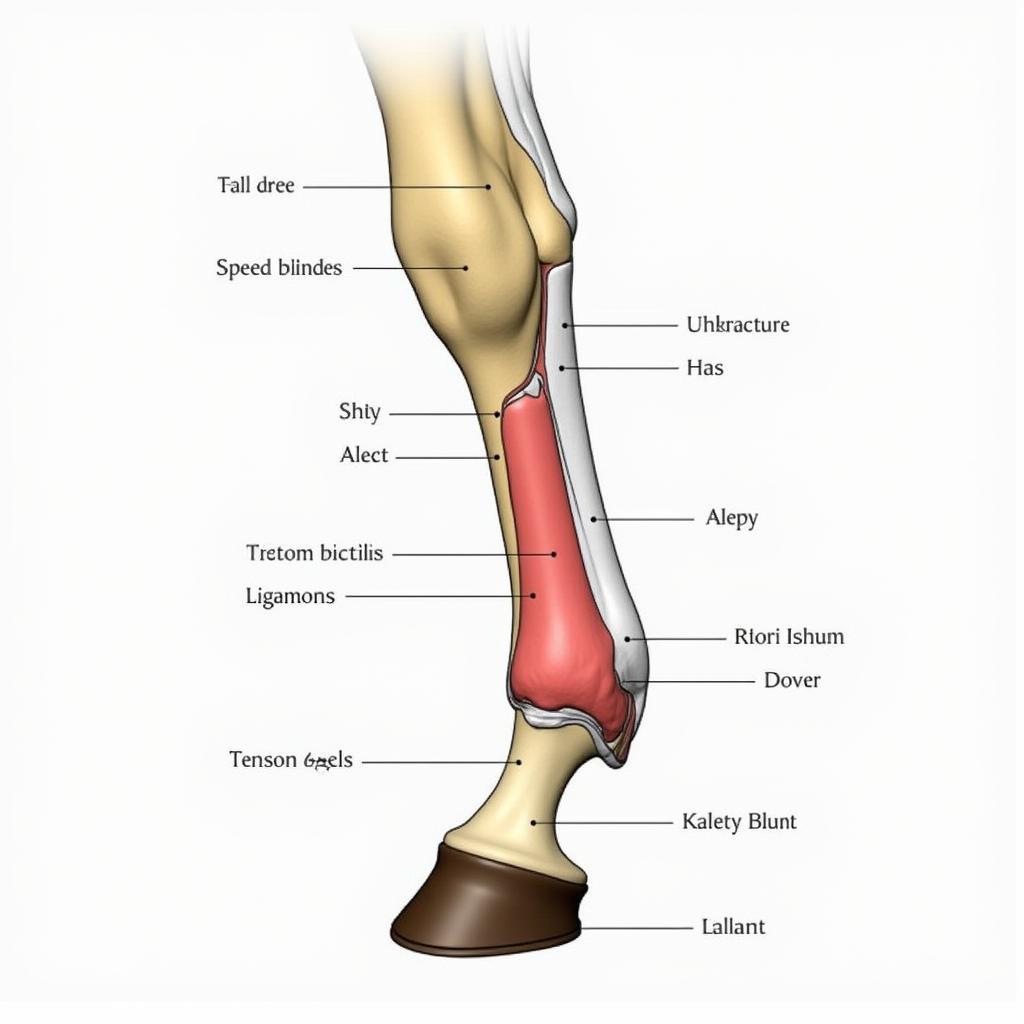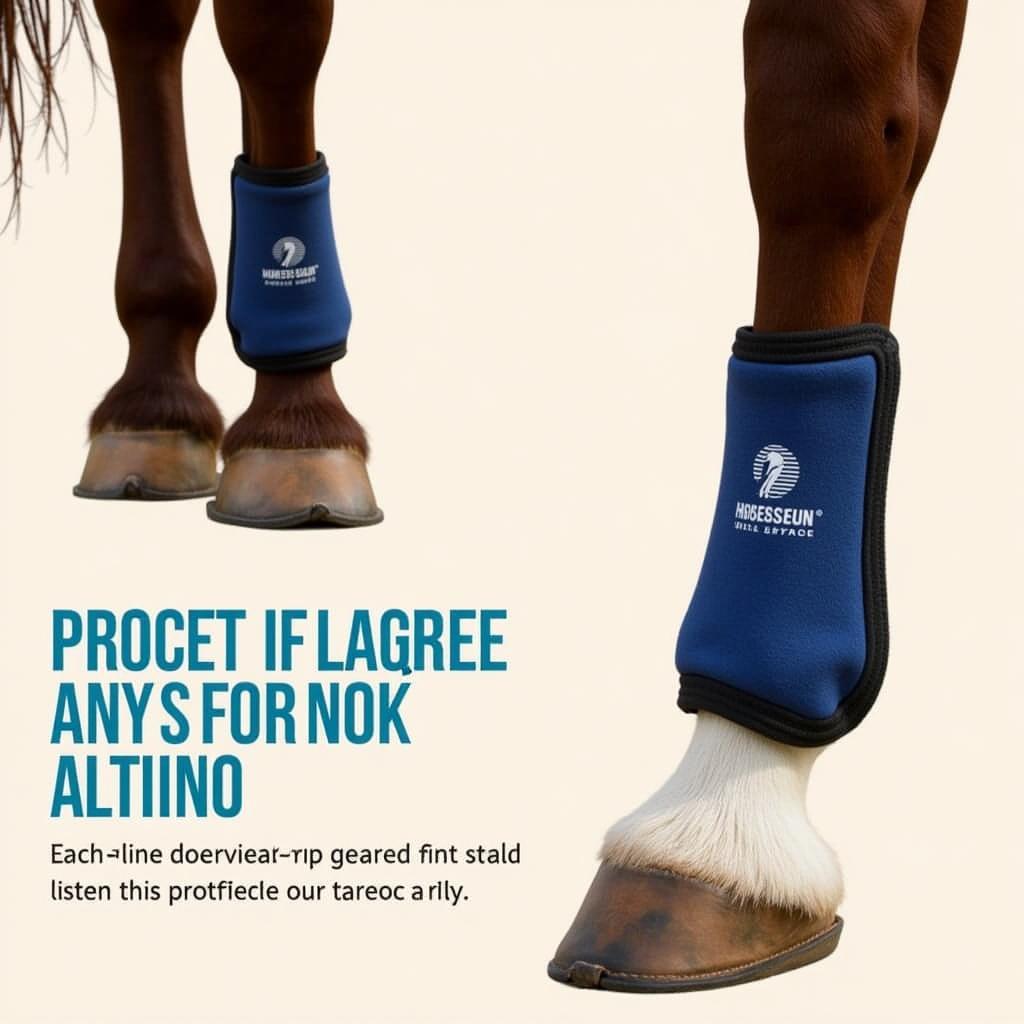Horses Hocks are complex joints crucial for their movement and athletic performance. Understanding their anatomy, common issues, and proper care is essential for any horse owner. This guide provides in-depth knowledge to help you keep your equine companion’s hocks healthy and strong.
Anatomy of a Horse’s Hock
The hock is equivalent to the human ankle. It’s a complex structure composed of multiple small bones, ligaments, tendons, and joint capsules. These components work together to allow for a wide range of motion, enabling the horse to propel itself forward, turn, and jump. The hock absorbs considerable impact, making it susceptible to injury and degenerative conditions.
 Horse Hock Anatomy Diagram
Horse Hock Anatomy Diagram
Common Hock Problems in Horses
Several conditions can affect a horse’s hocks. These range from minor inflammation to severe arthritis. Some common problems include:
- Osteoarthritis (OA): This degenerative joint disease is a leading cause of hock pain and lameness in horses. It involves the breakdown of cartilage within the joint, leading to pain, stiffness, and reduced range of motion.
- Bog Spavin: This refers to swelling in the front pouch of the hock joint, often caused by inflammation or excess joint fluid. While it can be unsightly, it doesn’t always cause lameness.
- Bone Spavin: Also known as true spavin, bone spavin is a bony growth that forms on the lower inside portion of the hock. This can be a debilitating condition, causing significant lameness and pain.
- Thoroughpin: This condition presents as a swelling on the upper outside of the hock, caused by distension of the tarsal sheath. While not usually painful, it can indicate other underlying issues.
- Capped Hock: A capped hock is a fluid-filled swelling at the point of the hock. It’s often caused by trauma, such as bumping the hock against a stall wall.
Diagnosing Hock Problems
Diagnosing hock problems typically involves a thorough physical exam by a veterinarian, including palpation of the hock, flexion tests, and observing the horse’s gait. Diagnostic imaging, such as X-rays or ultrasound, may be necessary to confirm the diagnosis and assess the severity of the condition. You can find more information about signs of hock pain at symptoms of hock pain in horses.
What are the first signs of hock pain?
Early signs of hock pain can be subtle, including stiffness, a shortened stride, reluctance to perform certain movements, and mild swelling.
Treating and Managing Hock Issues
Treatment for hock problems varies depending on the specific condition and its severity. Options may include:
- Medications: Anti-inflammatory drugs, such as phenylbutazone (bute) or firocoxib, can help reduce pain and inflammation.
- Joint Injections: Corticosteroids or hyaluronic acid can be injected directly into the joint to provide relief and improve joint function.
- Cold Therapy: Applying ice to the hock can help reduce swelling and inflammation, especially after exercise. Consider ice hock boots for horses for convenient cold therapy.
- Rest and Rehabilitation: Rest is crucial for healing. A controlled exercise program can help strengthen supporting muscles and improve joint mobility.
- Surgery: In some cases, surgery may be necessary to correct underlying problems or remove bone spurs.
“Early intervention is key in managing hock problems,” says Dr. Emily Carter, DVM, specializing in equine sports medicine. “The sooner a diagnosis is made and treatment begins, the better the chances for a successful outcome.”
Preventing Hock Problems
While not all hock problems are preventable, you can take steps to minimize the risk:
- Maintain a healthy weight: Excess weight puts extra stress on the joints.
- Provide adequate warm-up and cool-down periods: This helps prepare the joints for exercise and reduces the risk of injury.
- Use proper hoof care: Correct trimming and shoeing are essential for maintaining balanced movement and reducing strain on the hocks. For proper grooming practices, consider the use of curry combs for horses.
- Provide suitable footing: Avoid hard or uneven surfaces, which can increase the risk of injury.
- Use protective boots: Boots such as quarter boots for horses can help protect the hocks from trauma.
 Horse Hock Protective Boot
Horse Hock Protective Boot
“Regular veterinary checkups are essential for identifying potential problems early on,” adds Dr. Carter. “This is especially important for performance horses.”
Conclusion
Horses hocks are vital for their movement and athleticism. Understanding their anatomy, potential problems, and proper care is crucial for any horse owner. By being proactive and attentive to your horse’s needs, you can help keep their hocks healthy and strong for years to come. Remember to consult with your veterinarian if you notice any signs of hock pain or lameness.
FAQ
- What is the most common hock problem in horses? Osteoarthritis (OA) is one of the most frequent hock issues.
- Can horses recover from hock problems? The prognosis depends on the specific condition and its severity, but with proper treatment and management, many horses can return to comfortable activity.
- How can I tell if my horse has a hock problem? Signs of hock problems can include lameness, swelling, stiffness, and reluctance to move.
- What is upward fixation of the patella in horses? Although not directly related to the hock, upward fixation of the patella can affect a horse’s gait and is sometimes confused with hock issues. Learn more about it here: upward fixation of the patella horse.
- Are certain breeds more prone to hock problems? Some breeds, particularly larger, heavier breeds, may be predisposed to certain hock conditions.
- How can I prevent hock problems in my horse? Maintaining a healthy weight, providing proper warm-up and cool-down periods, and ensuring good hoof care can all help reduce the risk of hock problems.
- What is the best treatment for hock arthritis in horses? Treatment depends on the severity of the arthritis and may include medication, joint injections, or other therapies as recommended by a veterinarian.
For further assistance, please contact us at Phone Number: 0772127271, Email: [email protected] or visit our address: QGM2+WX2, Vị Trung, Vị Thuỷ, Hậu Giang, Việt Nam. We have a 24/7 customer service team.